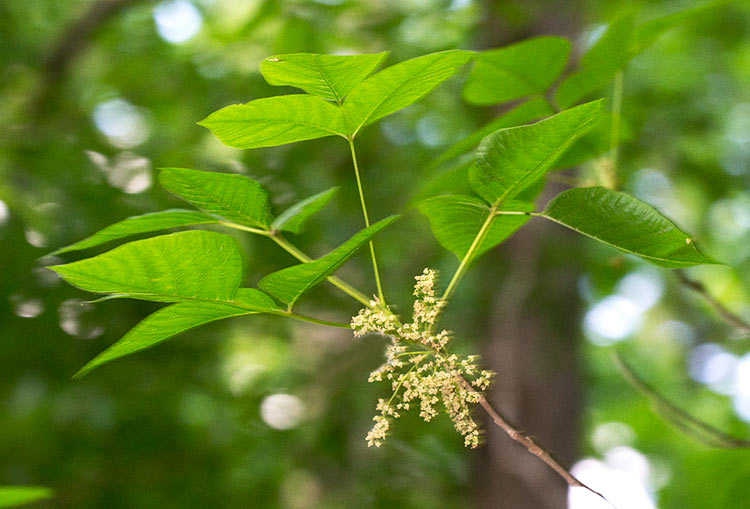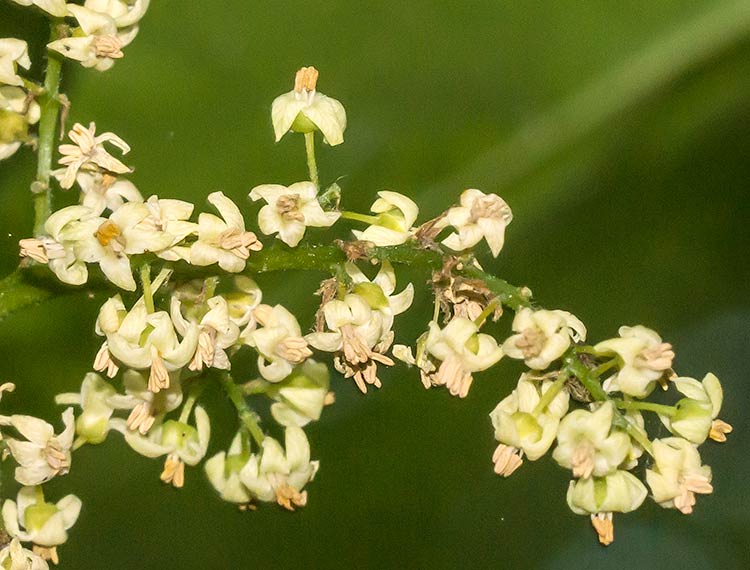We have several large Poison Ivy (Toxicodendron radicans) vines on trees in our woods. The characteristic compound leaf with three leaflets helps to identify them. Poison Ivy is found in Eastern Asia and Japan as well as North America.
This time of year Poison Ivy is in flower. The photograph above shows clusters of tiny white flowers. The flowers are quite attractive with their recurved petals and protruding stamens. Poison Ivy has separate male and female plants; the one pictured in this post is a male vine. Flowers on a female plant, if pollinated, will produce small, white berries that birds are eager to eat. We have a large female vine on another tree, and I will attempt to show some pictures of the berries in a future post when they mature in summer. Poison Ivy is not a true ivy (genus Hedera); it is in the plant family Anacardiaceae, which also includes the tree (Mangifera indica) that produces the mango fruits we buy in grocery stores and the Cashew Tree (Anacardium occidentale). These plants also contain compounds that may cause the contact dermatitus familiar to those who have had a bad experience with Poison Ivy.
The compound which causes contact dermatitis is urushiol (u-ROO-she-ol), a yellow oil that is found in all parts of the Poison Ivy Plant. Urushiol gets its name from the name of a tree called in Japanese “Urushi” (Toxicodendron vernicifluum), which is related to Poison Ivy. In China, Korea, and Japan, the milky-white sap from the tree is collected, filtered to remove debris, and partially dried to remove excess water. Iron oxide or various pigments may be added to color the raw urushi (as it is called in Japan). Lacquerware has been made using urushi for thousands of years in China, and the technique was exported to Japan hundreds of years ago. A famous type of laquerware (Urushi Ware) is made in Japan by painting layers of this material on ceramics, wood, paper and many other materials. After it is applied, a reaction with oxygen and an enzyme present in the urushi causes the material to polymerize as it dries to produce a very hard lacquer that is waterproof and resistant to mold, acids, and alkali. A thin coat of the raw urushi is brushed on and allowed to dry under specific conditions of temperature and humidity, then another coat, until as many as 30 or 40 coats have been applied. One artist claims the best brush for applying urushi is hair from the armpit of a rat! A fine art piece of Urushi Ware may take two months or more to produce. The liquid solution of urushiol that is used to paint the base material is toxic. Artists who use this material have to be very skilled and careful if they are susceptible to urushiol-induced dermatitis. It is fortunate that susceptibility to urushiol is less common among Japanese (and Native Americans).
If you are exposed to Poison Ivy, it is possible to wash away the urushiol with soap and lots of cold water (hot water might open pores in the skin and allow easier access to the urushiol) to prevent dermatitus. However, this must be done very quickly. Urushiol quickly binds firmly to skin (50% is bound within 10 minutes). After it is bound to skin, it cannot be washed away. Under no circumstances should Poison Ivy plants be burned. It takes a very hot fire to destroy urushiol; if the fire smolders, urushiol may be dispersed into the air. Inhaling the smoke from such a smoldering fire can be very dangerous. Also, remember that urushiol can remain potent on clothing, shoes or other items for a year or more. Laundering in a washing machine will usually safely remove it.
Only humans appear to be allergic to Poison Ivy. Many animals eat the leaves or berries with no harmful effects. Dogs and cats can come into contact with Poison Ivy without ill effect (but can transfer the urushiol to humans who come in contact with them). Unless you are one of the minority who are immune to Poison Ivy, be careful!
I really got interested in Urushi Ware and lacquerware in general in writing this post. If you are interested in learning more here are some links to get you started:
Kyoto Visitor Guide – Examples of Urushi Ware
Background Information on Urushi Lacquer
Visit to a facility producing Urushi-lacquered fountain pens


